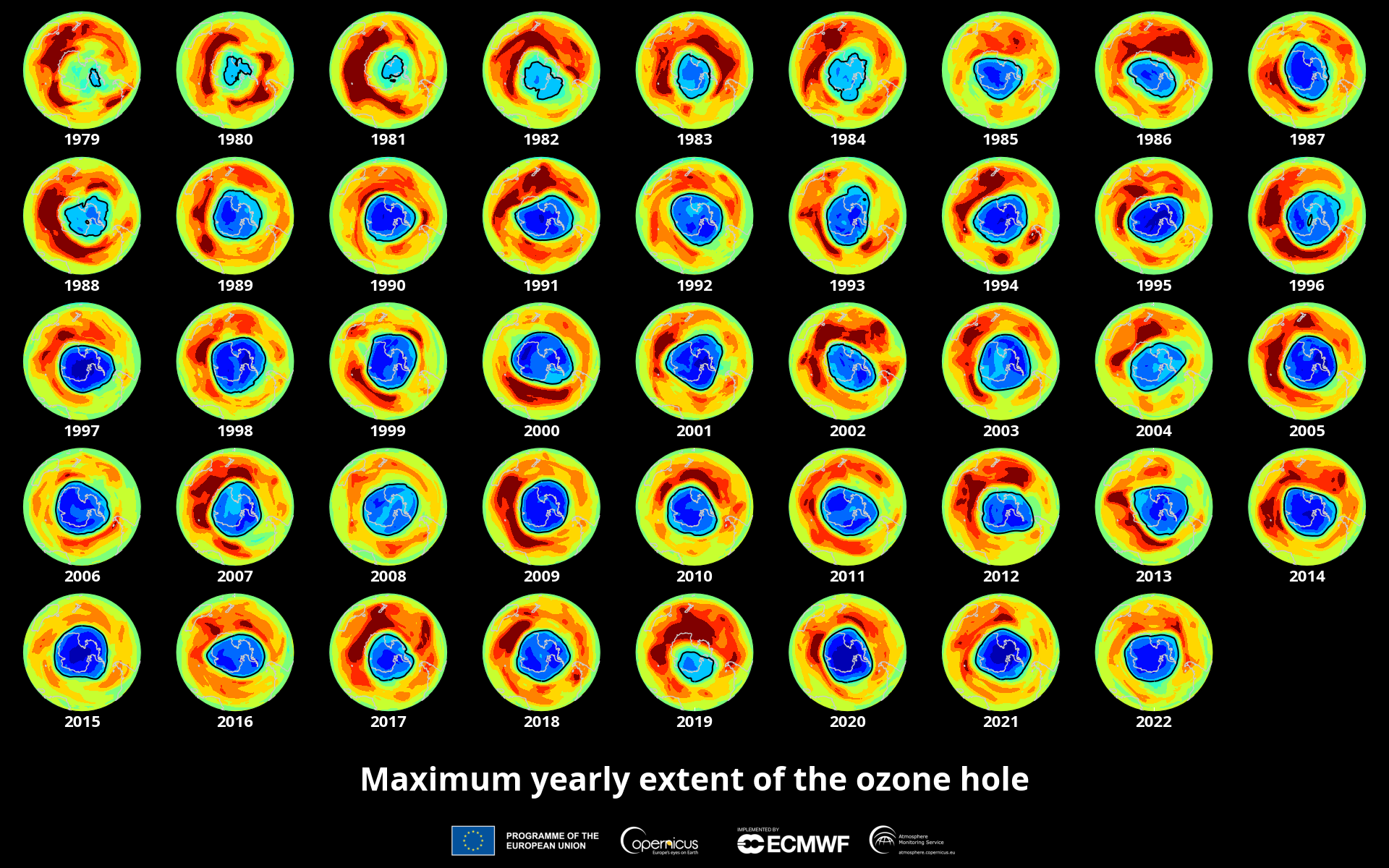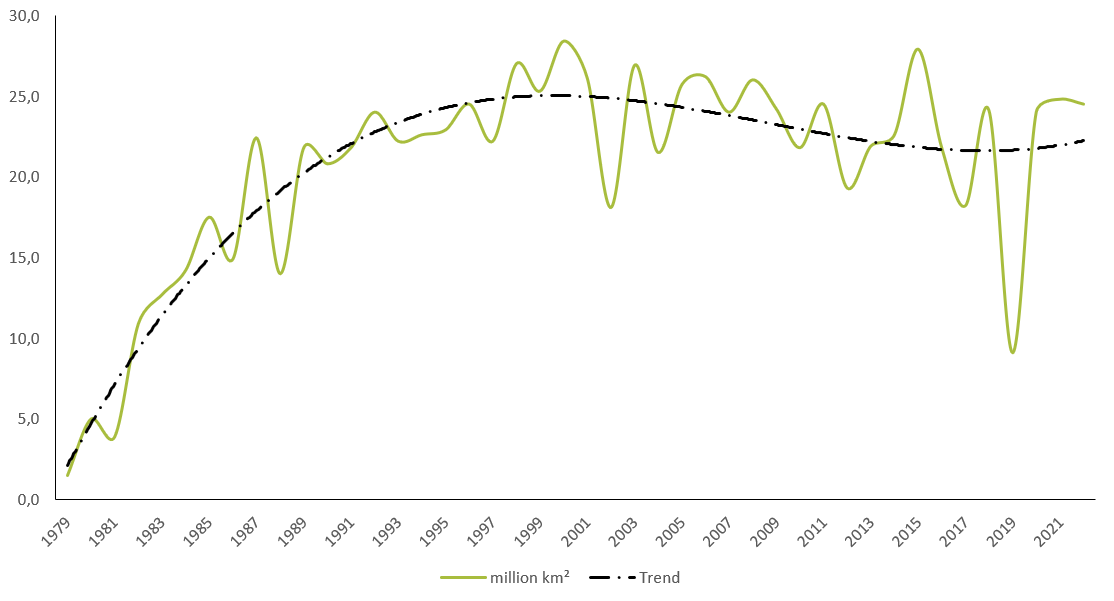Key messages
- A significant reduction in the consumption of ozone-depleting substances (ODS) has been achieved globally since 1986. This reduction has largely been driven by the 1987 United Nations Environment Programme (UNEP) Montreal Protocol.
- The largest historical extent of the ozone hole — 28.4 million km² — occurred in September 2000. This area is equivalent to almost seven times the territory of the EU.
- In late September 2022, the Antarctic ozone hole reached its maximum area with 24.5 million km².
- Up until early November 2022, the Antarctic ozone hole has been similarly large and long-lasting to the ones in 2021 and 2020 [i].
Depletion of stratospheric ozone occurs over both hemispheres of the Earth. However, this phenomenon is more pronounced in the Southern Hemisphere (Antarctica) than in the Northern Hemisphere (Arctic). This is the case because the formation of the ozone hole is directly linked to the stratosphere's temperature. Once temperatures drop below -78°C, polar stratospheric clouds tend to form, which exacerbate ozone depletion. In the Antarctic, long presence of low temperatures in the stratosphere are stimulating their formation, whereas the Arctic is characterised by larger year-to-year meteorological variability.
Generally, the ozone hole is defined as the area for which ozone column values amount to 220 Dobson Units (DU) or less, marked by the thick contour line and represented in blue colours in Figure 1. This is only apparent in the Southern Hemisphere. Here, the largest historical extent of the ozone hole - 28.4 million km² (Figure 1 and 2) - occurred in September 2000. This area is equivalent to more than six times the territory of the EU.

Note: Copernicus analyses of total ozone column over the Antarctic. The blue colours indicate lowest ozone columns, while yellow and red indicate higher ozone columns. Ozone columns are commonly measured in Dobson Units. One Dobson Unit is the number of molecules of ozone that would be required to create a layer of pure ozone 0.01 millimetres thick at a temperature of 0 degrees Celsius and a pressure of 1 atmosphere. 300 DU corresponds to 3 millimetres of ozone.
Data source: Copernicus Atmosphere Monitoring Service (CAMS).
In 2000, the ozone hole reached its maximum extent since 1979 and has stopped increasing in size in subsequent years, which is attributable to the phasing out of ozone-depleting substances under the Montreal Protocol (for more information, see the EEA indicator 'Consumption of ozone-depleting substances'). Since 2001, with ODS-emissions in check, the ozone layer is showing signs of healing with variations in size between years that are strongly driven by stratospheric temperature, with warmer temperatures leading to a smaller ozone hole, such as in 2019 (for more information, visit the website of the Copernicus Atmosphere Monitoring Service).
However, this cannot directly be attributed to anthropogenic climate change, since greenhouse gases generally have a cooling effect in the stratosphere, while they contribute to global warming in the troposphere. This stratospheric cooling has a positive effect on ozone recovery, except for the polar regions. Here, very low temperatures can lead to an increase in the formation of polar stratospheric clouds, which facilitate ozone depletion. The ozone hole can also be periodically influenced by volcanic eruptions and forest wildfires, increasing the stratospheric particle load and thereby depleting ozone. This partially explains those occasional years during which the ozone hole is comparatively large, e.g. in 2015 (27.9 million km²).

Note: The ozone hole is a region of exceptionally depleted ozone in the stratosphere over the Antarctic. All figures are in million square kilometres. The trend is the result of a 3rd degree polynomial function with an R2 of 0.765.
Data source: Copernicus Atmosphere Monitoring Service (CAMS).
This year's ozone hole over the Southern Hemisphere showed a maximum area of 24.5 million km² on 26 September (Figure 2) and resembles the one from 2021 (24.8 million km²). The 2022 ozone hole has been similar in size and persistence to the ones in 2021 and 2020, due to a strong and long-lasting polar vortex in those years, according to researchers from the Copernicus Atmosphere Monitoring Service. Moreover, the size in 2022 was larger than the average over the last five and ten years (21.3 and 21.9 million km², respectively). In the Northern Hemisphere, ozone depletion is usually much more limited compared to the Southern Hemisphere. In Artic spring 2020, however, ozone-sonde measurements indicated ozone depletion that occurred due to unusually strong, long-lasting cold temperatures in the stratosphere.
The 2019 ozone hole has been very small and short-lived, which was mostly driven by unusual meteorological conditions. In particular, August and September 2019 showed exceptionally high temperatures at altitudes between 20 and 30 km above the Antarctic, stopping the formation of icy clouds that usually trap ozone-depleting molecules that, when released during springtime in the Southern Hemisphere, trigger ozone destruction. Taken together, the mitigation of ozone depletion is still very fragile and scientific evidence suggests that more action is still required to remove pressure on the ozone layer caused by ODS.
Browse the for more information on ozone-depleting substances.
Photo: © Arif Miletli, Sustainably Yours /EEA
Scientific References
- Safieddine, S., Bouillon, M., Paracho, A.‐C., Jumelet, J., Tencé, F., Pazmino, A., et al. (2020). Antarctic ozone enhancement during the 2019 sudden stratospheric warming event. Geophysical Research Letters, 47, e2020GL087810. https://doi.org/10.1029/2020GL087810
- Wohltmann, I., von der Gathen, P., Lehmann, R., Maturilli, M., Deckelmann, H., Manney, G. L., et al. (2020). Near ‐ complete local reduction of Arctic stratospheric ozone by severe chemical loss in spring 2020. Geophysical Research Letters, 47, e2020GL089547. https://doi.org/10.1029/2020GL089547
- World Meteorological Organization (WMO). Executive Summary. Scientific Assessment of Ozone Depletion: 2022, GAW Report No. 278, 56 pp.; WMO: Geneva, 2022. https://csl.noaa.gov/assessments/ozone/2022/downloads/executivesummary.pdf


Document Actions
Share with others